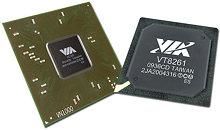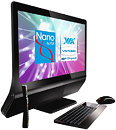Thursday, December 10th 2009

VIA Brings Enhanced Windows 7 Desktop to Life with Power Efficient DX10.1 Chipset
VIA Technologies, Inc, a leading innovator of power efficient x86 processor platforms, today announced the VIA VN1000 digital media chipset for next generation desktop and all-in-one PCs, offering a world-class HD multimedia entertainment platform compatible with the advanced desktop features of Microsoft Windows 7.
The VIA VN1000 is the most power efficient DX10.1 digital media chipset available today, making it the perfect solution for next generation small form factor and all-in-one Windows 7 PCs that focus on entertainment, multimedia and touch screen capabilities. The DirectX 10.1 hardware environment provided by the VIA Chrome 520 IGP means Windows 7 users can enjoy a more fluid and visually enhanced desktop experience as well as the latest gaming titles.The VIA VN1000 digital media chipset features the ChromotionHD 2.0 video processor to guarantee smooth playback of the latest Blu-ray titles with superb hardware acceleration of the most demanding H.264, WM9 and VC1 codecs over the latest display technologies, including Display Port and HDMI.
"The VIA VN1000 leverages our optimized VIA Nano 3000 Series processors, creating the most balanced, power-efficient, multimedia-focused desktop platform on the market today," said Richard Brown, VP International Marketing, VIA Technologies, Inc. "Supporting the latest system memory, graphics and entertainment standards, the VIA VN1000 takes the VIA processor platform to new heights of power-efficient visual sophistication."
At the core of the VIA VN1000 lies a DirectX 10.1 graphics engine, a necessary requirement for users who want to enjoy the enhanced features of the Windows 7 desktop environment. The DirectX 10.1 engine means that Windows 7 can employ Microsoft's advanced Windows Desktop Driver Model 1.1, bringing significant gains in system memory efficiency, overall desktop responsiveness and an improved visual experience compared to WDDM 1.0.
VIA VN1000 Product Highlights
Paired with the new VIA VT8261 south bridge, the VIA VN1000 represents the most power-efficient DX10.1 compliant digital media chipset on the market, consuming up to 12 watts for both north and south bridges, making it a perfect choice for Windows 7 based mini desktop and all-in-one desktop PCs designs.
Offering a feature-rich specification with significant emphasis on graphics and HD video playback, the VIA VN1000 features the VIA Chrome 520 IGP, combining a DirectX 10.1 graphics engine, with support for Shader Model 4, OpenGL 3.0 graphics and OpenCL 1.0 for next-generation GPGPU applications.
The high-performance ChromotionHD 2.0 video processor offers advanced filtering and cutting edge post-processing to perform ultra smooth decoding of MPEG-4/AVC, H.264, MPEG-2, VC-1, WMV-HD, and AVS video for Blu-ray content. The home theatre experience also encompasses support for the latest connectivity standards, including dual channel support for Display Port, HDMI, DVP, VGA and LVDS/TMDS.
The VIA VN1000 supports DDR3 system memory at speeds of up to 1066MHz, one x8 lane and four x1 lane PCI Express II expansion slots, up to five PCI slots and a VIA Vinyl HD 8 channel audio codec. An IDE controller, support for up to four S-ATA II drives, SD/MMS/MMC card reader support and 12 USB 2.0 ports are supplemented with support for PS/2, SPI, GPIO and LPC technologies.
The VIA VN1000 Digital Media IGP Chipset is fully compatible with all VIA Nano, VIA C7, VIA C7-M and VIA Eden processors and supports all Microsoft Windows platforms and popular Linux distributions.
The VIA VN1000 is the most power efficient DX10.1 digital media chipset available today, making it the perfect solution for next generation small form factor and all-in-one Windows 7 PCs that focus on entertainment, multimedia and touch screen capabilities. The DirectX 10.1 hardware environment provided by the VIA Chrome 520 IGP means Windows 7 users can enjoy a more fluid and visually enhanced desktop experience as well as the latest gaming titles.The VIA VN1000 digital media chipset features the ChromotionHD 2.0 video processor to guarantee smooth playback of the latest Blu-ray titles with superb hardware acceleration of the most demanding H.264, WM9 and VC1 codecs over the latest display technologies, including Display Port and HDMI.
"The VIA VN1000 leverages our optimized VIA Nano 3000 Series processors, creating the most balanced, power-efficient, multimedia-focused desktop platform on the market today," said Richard Brown, VP International Marketing, VIA Technologies, Inc. "Supporting the latest system memory, graphics and entertainment standards, the VIA VN1000 takes the VIA processor platform to new heights of power-efficient visual sophistication."
At the core of the VIA VN1000 lies a DirectX 10.1 graphics engine, a necessary requirement for users who want to enjoy the enhanced features of the Windows 7 desktop environment. The DirectX 10.1 engine means that Windows 7 can employ Microsoft's advanced Windows Desktop Driver Model 1.1, bringing significant gains in system memory efficiency, overall desktop responsiveness and an improved visual experience compared to WDDM 1.0.
VIA VN1000 Product Highlights
Paired with the new VIA VT8261 south bridge, the VIA VN1000 represents the most power-efficient DX10.1 compliant digital media chipset on the market, consuming up to 12 watts for both north and south bridges, making it a perfect choice for Windows 7 based mini desktop and all-in-one desktop PCs designs.
Offering a feature-rich specification with significant emphasis on graphics and HD video playback, the VIA VN1000 features the VIA Chrome 520 IGP, combining a DirectX 10.1 graphics engine, with support for Shader Model 4, OpenGL 3.0 graphics and OpenCL 1.0 for next-generation GPGPU applications.
The high-performance ChromotionHD 2.0 video processor offers advanced filtering and cutting edge post-processing to perform ultra smooth decoding of MPEG-4/AVC, H.264, MPEG-2, VC-1, WMV-HD, and AVS video for Blu-ray content. The home theatre experience also encompasses support for the latest connectivity standards, including dual channel support for Display Port, HDMI, DVP, VGA and LVDS/TMDS.
The VIA VN1000 supports DDR3 system memory at speeds of up to 1066MHz, one x8 lane and four x1 lane PCI Express II expansion slots, up to five PCI slots and a VIA Vinyl HD 8 channel audio codec. An IDE controller, support for up to four S-ATA II drives, SD/MMS/MMC card reader support and 12 USB 2.0 ports are supplemented with support for PS/2, SPI, GPIO and LPC technologies.
The VIA VN1000 Digital Media IGP Chipset is fully compatible with all VIA Nano, VIA C7, VIA C7-M and VIA Eden processors and supports all Microsoft Windows platforms and popular Linux distributions.



28 Comments on VIA Brings Enhanced Windows 7 Desktop to Life with Power Efficient DX10.1 Chipset
The second sounds about right though.
12W is only a good figure because of the computational power that provides. The original Atom platform used about that amount, but this nano and this igp can give quite tangible performance increases (30-50% with the CPU, probably more than 100% with the GPU) over the atom at the same power consumption.
It's pretty easy to make a comparison:
- The Chrome 540 (32 shaders) has similar performance to the HD 4350 (80 shaders) but is higher clocked
- IGP 780G & 785G have 40 shaders and have the same performance
- IGP 785G has similar performance to GF9300 IGP and GF9400 IGP is a bit faster (around 10%)
- All IGP's have similar bandwidth at their disposal
Taking into account that the Chrome 520 IGP has a 37.5% lower clock compared to the 540 but the same amount of shaders.
Taking into account that the HD 4200 IGP has a 13% lower clock compared to the HD 4350 but half the amount of shaders.
Just going by these numbers, the Chrome 520 IGP would be around 40% faster than the HD 4200 IGP. That would also mean faster than the GF9400 IGP.
I know GPU performance is not easy math like i just did but my numbers do give a good indication of what to expect. I'm pretty sure it won't be slower than the 785G or GF9300IGP.
nVidia's ION is even a bit lower clocked than the GF9300IGP (450/1100 vs 450/1200).
A Via Nano 3000 + VN1000 combo would seriously outperform an Atom + ION combo at similar power levels. Let's just hope someone is brave enough to make it.